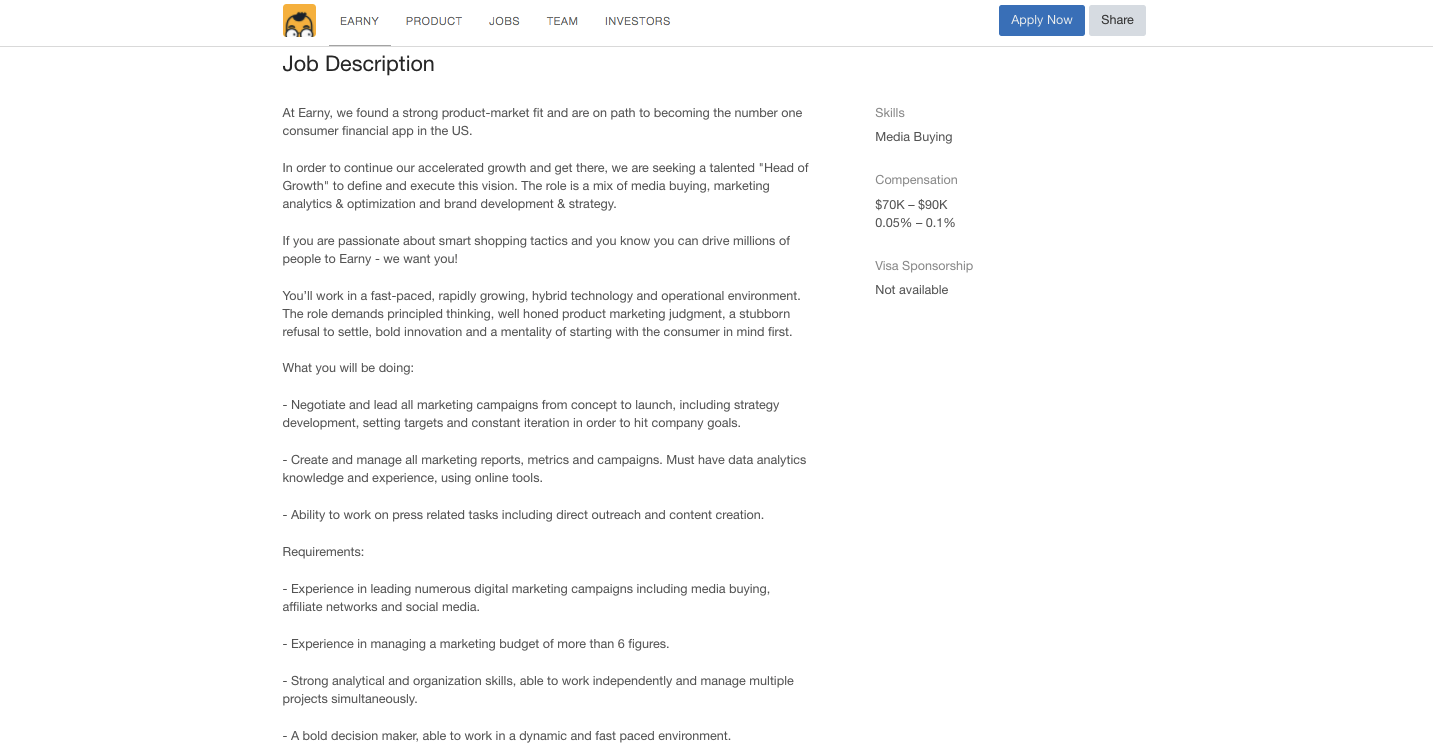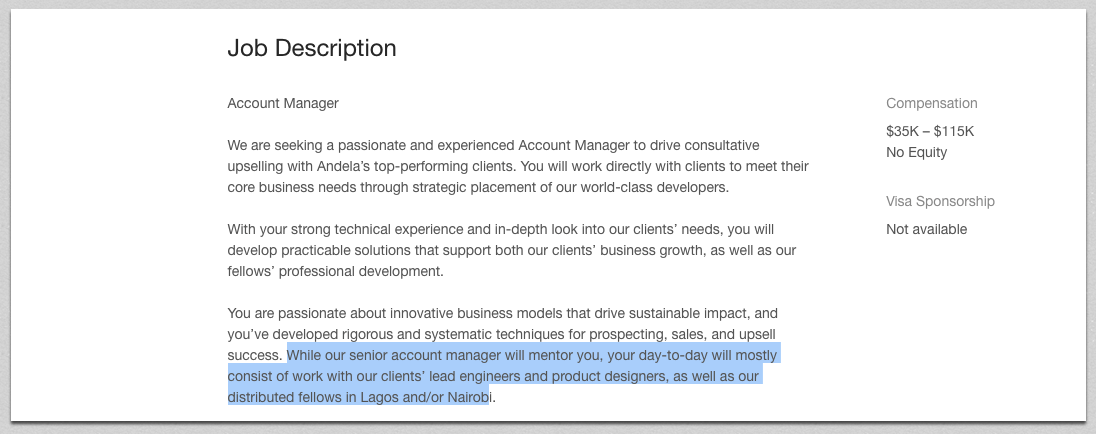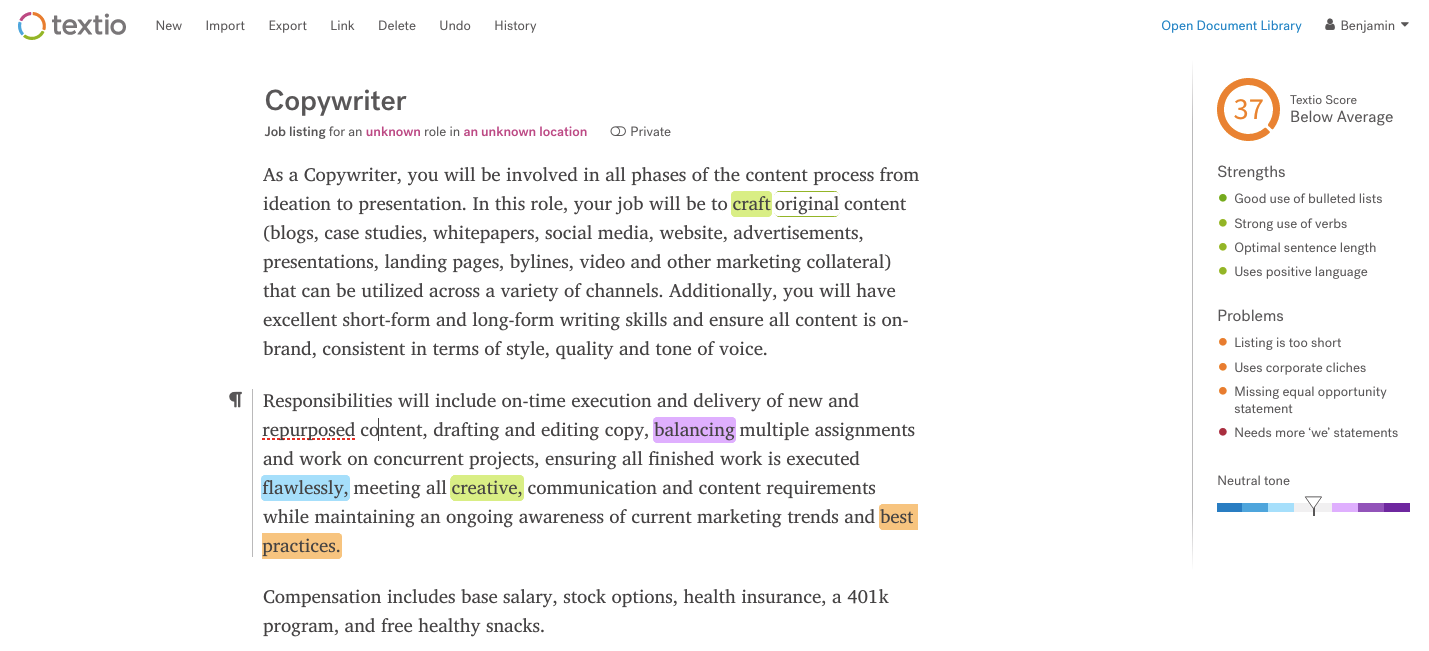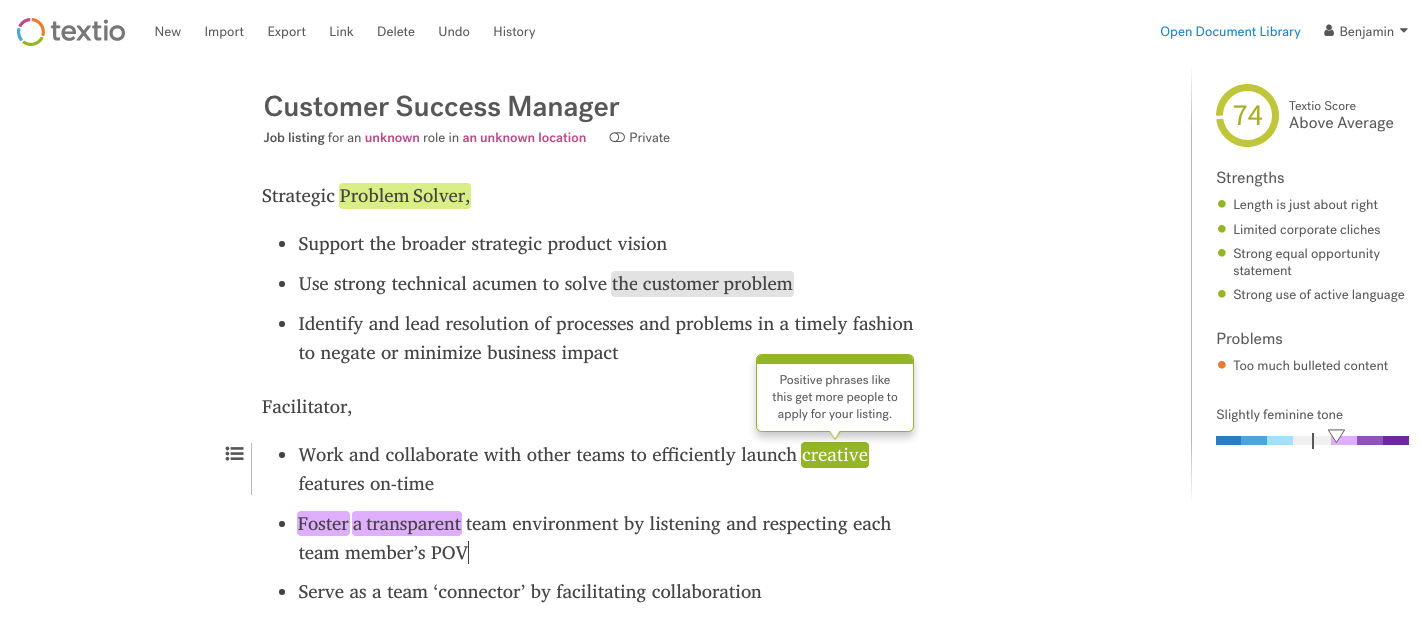
Do you know how long a prospective candidate will spend reading your job ad?
Six seconds.
With more than three billion job listings online at any given moment, standing out from the crowd might mean the difference between finding the greatest team member possible or having to settle for the best of a bad bunch.
Data from 2015 suggests that 100 million startups are launched annually. And, as the number of competitors rockets up, the pool of available talent is diluted, leaving you with less choice.
The solution?
A clear and compelling job description. It’s more complex than it first seems, but in this article I’ll be sure to make it easy.
When a prospective candidate sees your job posting, they’re likely to be unaware of who you are, and what exactly your company is, and what you’re looking for. According to CareerBuilder:
- 79% of job-seekers look first at the list of job requirements
- 72% look first at the salary
- 68% look first at the company information
Basically, they’re in the mindset of ‘will you take me and what will you pay me?’, as well as evaluating their culture fit.
With this information, you can make the best use possible of those six seconds of attention span you get.
What is a job description?
The term ‘job description’ is a flexible one, but here I’ll be using it in a modern context, to describe all of the copy you’d use on an online job board. It usually includes information like job title, duties, salary, etc.
The purpose of a job description is to persuade, as well as to qualify and disqualify candidates before you spend time interviewing them. If you’re looking for someone with a degree in economics, then putting that on the job requirements list will disqualify the candidates without the necessary qualification. On the other hand, the right copy and tone can help you stand out to incredibly desirable candidates.
Additionally, job descriptions are handy for both employees and managers: after hiring, both can refer back to the responsibilities and other information to gauge how well they’re doing their job and whether they’re matching expectations.
Job descriptions usually consist of 6 core elements:
- Job title
- Job description summary
- Job duties
- Skills & qualifications
- Salary & benefits
- Company description
Here’s a typical example from AngelList:

Here’s the full text version of the job ad screenshotted above, to give you an idea of the structure:
Job description example & anatomy
Job title:
Head of Growth
Job description summary:
At Earny, we found a strong product-market fit and are on path to becoming the number one consumer financial app in the US.
In order to continue our accelerated growth and get there, we are seeking a talented “Head of Growth” to define and execute this vision. The role is a mix of media buying, marketing analytics & optimization and brand development & strategy.
If you are passionate about smart shopping tactics and you know you can drive millions of people to Earny – we want you!
You’ll work in a fast-paced, rapidly growing, hybrid technology and operational environment. The role demands principled thinking, well honed product marketing judgment, a stubborn refusal to settle, bold innovation and a mentality of starting with the consumer in mind first.
Job duties:
— Negotiate and lead all marketing campaigns from concept to launch, including strategy development, setting targets and constant iteration in order to hit company goals.
— Create and manage all marketing reports, metrics and campaigns. Must have data analytics knowledge and experience, using online tools.
— Ability to work on press related tasks including direct outreach and content creation.
Skills & qualifications:
— Experience in leading numerous digital marketing campaigns including media buying, affiliate networks and social media.
— Experience in managing a marketing budget of more than 6 figures.
— Strong analytical and organization skills, able to work independently and manage multiple projects simultaneously.
— A bold decision maker, able to work in a dynamic and fast paced environment.
Salary & benefits:
$70K – $90K
0.05% – 0.1% equity
Company description:
Every year, consumers in the US, lose 50 billion dollars in unclaimed money and we’ve developed a simple, straightforward and genius way of solving that
As we’ll look at later on in the article, there’s plenty that could be improved about the copy of this job description, but in essence the structure is clear, logical and comprehensive.
How to write a great job description
It’s easy to get job descriptions wrong. Your vocabulary and clarity will have a drastic psychological affect on the prospective applicant. Whether that’s negative or positive is up to you.
In this section, I’m going to explain the anatomy of a great job listing, and then — with the help of Textio — show you how to write one (words to use and words to avoid).
But first, here’s a job description template we put together earlier as part of our free HR templates pack:
Come up with a clear job title
While there’s no true agreed-upon hierarchy, it matters whether you say you’re looking for a Marketing Manager or a VP of Marketing. As a quick reference, here’s the typical hierarchy of job titles, listed by seniority:
- Chief Executive Officer
- Non-CEO C-Level (COO, CFO, etc.)
- President
- Executive Vice President
- Senior Vice President
- Vice President
- Assistant Vice President
- Associate Vice President
- Senior Director
- Director
- Assistant Director
- Manager
- Middle Manager of people or a function
- Employees, freelancers, contract employees, temporary employees, contingent employees. part time employees
Of course, terminology will vary; some companies are against ‘Head of’ job titles, while some companies will make up anything that sounds about right (VP of Misc. Stuff, for example). Job titles are as much for you to communicate the job function as they are for expressing specifics of your brand, company and the desired candidate.
Open with a hook
Often you’ll see companies open their job descriptions with eye-catching statements or questions. Julie Strickland writing for Inc recommends this tactic, too, advising you to think about what kind of company visions would appeal to the ideal candidate.
This ad looking for a writer opens with a quote that sums up their attitudes (and hopefully those of the applicant):

Use bullet points
Just as with any kind of content, your focus should be on making it scannable and readable. Especially when it comes to the requirements and skills, which is the #1 thing 78% of job seekers look at first. It’s much better to show every requirement in a list than it is to knock out a huge paragraph, burying the requirements inside.
Distinguish between a requirement and a preference
You have to be careful with making your job ad too restrictive, and not confuse nice-to-haves as must-haves. Some candidates might only have four years experience, not six, but have learned more in those four years than others have in a decade. Also, using overly strict language might make your company seem authoritarian and harsh.
Share your company’s vision and mission
If your company’s vision — told how it is — actually resonates with a jobseeker, you’re going to be likely to find a candidate who is truly in tune with your organization’s culture and mission.
Chameleon opens its ad with some impressive stats and a challenge to potential applicants:
“We’re scrappy and have got to six-figure ARR within a year of launch. We now want to boost that 5-10x in the next year and need someone to lead that!”
The goal is clear, and applicants with motivated, problem-solving mindsets would get excited about that.
Write a specific summary that explains the day-to-day work
Jobseekers want to be able to imagine their bright futures at your company, but it’s also important to be upfront about what their day will look like. That way, prospective hires can get a better idea whether they will fit in and whether they will enjoy the job.

Making it easy for a jobseeker to imagine their day-to-day life is a proven persuasion technique, and is commonly used by advertisers.
Keep it within 300-700 words
Many job descriptions are too brief. While jobseekers will typically only spend 6 seconds reading them, as long as they’re scannable and within 300-700, Textio says you’re likely to get better results.

Paste in and fill out this template to write your job listing
In reality, you’re probably going to put your job listing straight into whatever site you’re posting on. Whether you choose to paste it right in or paste it somewhere to keep it on record, you can use this template below to make things easier:
Job title: Job description summary: Job duties: * Write, edit and peer-proof articles for our company blog * etc. Required skills and qualifications: * Advanced proficiency with Microsoft Office suite * etc. Salary: $XXk X% equity Company description:
Editing and optimizing your job posting
As I mentioned before Textio is an insanely useful tool for writing job descriptions. Using text analysis algorithms trained on 15 million job ads, it detects negative, weak, biased or overly-corporate language and offers strong suggestions to improve the quality of your writing.
Here’s an example job description from Ambassador:
As a Copywriter, you will be involved in all phases of the content process from ideation to presentation. In this role, your job will be to craft original content (blogs, case studies, whitepapers, social media, website, advertisements, presentations, landing pages, bylines, video and other marketing collateral) that can be utilized across a variety of channels. Additionally, you will have excellent short-form and long-form writing skills and ensure all content is on-brand, consistent in terms of style, quality and tone of voice.
Responsibilities will include on-time execution and delivery of new and repurposed content, drafting and editing copy, balancing multiple assignments and work on concurrent projects, ensuring all finished work is executed flawlessly, meeting all creative, communication and content requirements while maintaining an ongoing awareness of current marketing trends and best practices.
Compensation includes base salary, stock options, health insurance, a 401k program, and free healthy snacks.
Pasting it into Textio, I can already see there’s some issues with it.

Blue and pink highlights show you which gender of candidate would be attracted or put off by certain words. It’s a common bad habit to bias language towards the masculine side of the scale, since often organizations look for ‘driven’ ‘ninjas’ to ‘crush it’.
Other Textio features include stronger language suggestions (for example, editing x to y), indication of whether the listing is too long or short, equal opportunity suggestions, and repeated phrase detection.
The app has just one purpose, but it’s the best at what it does.
To test the tool, I found this description of the right length but, according to Textio, with a few big problems. After taking on suggestions from Textio, I improved the description in about 5 minutes from a score of 30 to a score of 74 — above average.

Where to post your ad
I won’t go into too much detail about where to post your job ad since this is about writing, but a quick list is handy:
- Indeed
- Monster
- CareerBuilder
- Beyond
- StackOverflow (tech)
- AngelList (startups)
There are also a number of services that will post your ad to several boards at once, like Workable, Betterteam, and Greenhouse. Depending on the charges you have to pay for individual boards, these paid options could work out cheaper.
Examples of job listings (with Textio score in brackets)
Here’s a sample of job descriptions, ranked from good to bad. Looking through them alongside their scores makes it obvious why some are better than others, and is a good exercise to teach yourself to get better at writing them:
- Territory Sales Manager (80)
- Digital Freelance Journalist (79)
- Senior Frontend Developer, JavaScript, React/Redux, ES6 (76)
- Site Reliability Engineer (75)
- Content Writer (73)
- Director, Wireless B2B Product Marketing (63)
- Data Science and Marketing Analyst (49)
- Sales Development Representative (46)
- Branch Receptionist (44)
- Designer (25)
- Behavior Analyst (20)
- Machine Learning Research Scientist (4)
To summarize…
Writing job descriptions is deceptively difficult. It’s a vital part of scaling your business while maintaining consistency because it ensures you’ll end up with employees who are a better fit for your organization.
My recommendation would be to structure the process. You can use our job description template inside Process Street to assign the task to the HR department, or you can use the template to help you write your own.
Click here to get our template and systemize this vital part of your business.
Any questions or comments? Leave them below. 🙂







 Workflows
Workflows Projects
Projects Data Sets
Data Sets Forms
Forms Pages
Pages Automations
Automations Analytics
Analytics Apps
Apps Integrations
Integrations
 Property management
Property management
 Human resources
Human resources
 Customer management
Customer management
 Information technology
Information technology



Benjamin Brandall
Benjamin Brandall is a content marketer at Process Street.